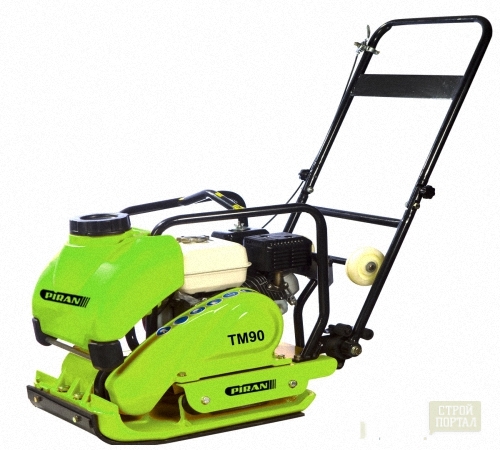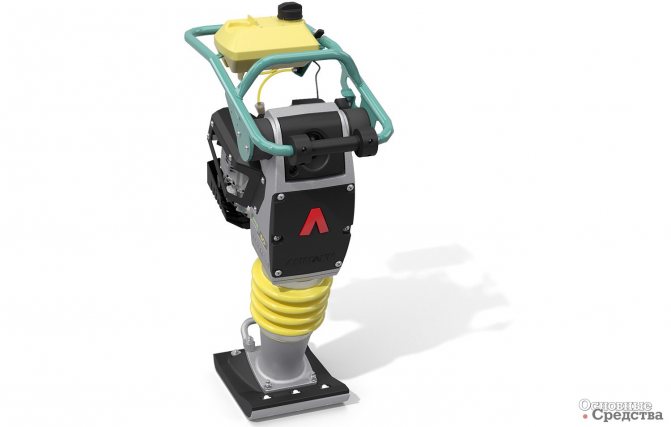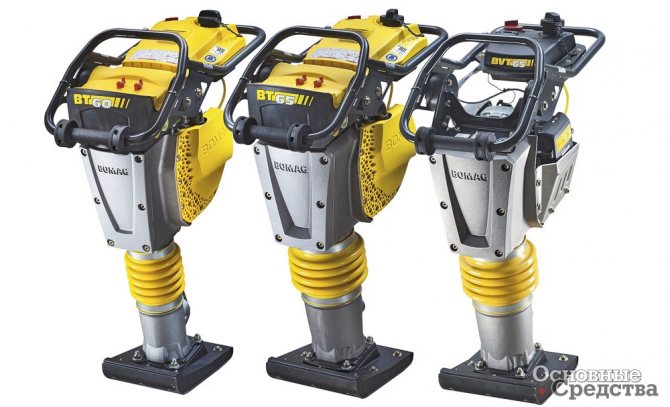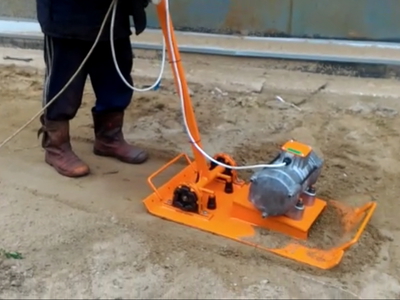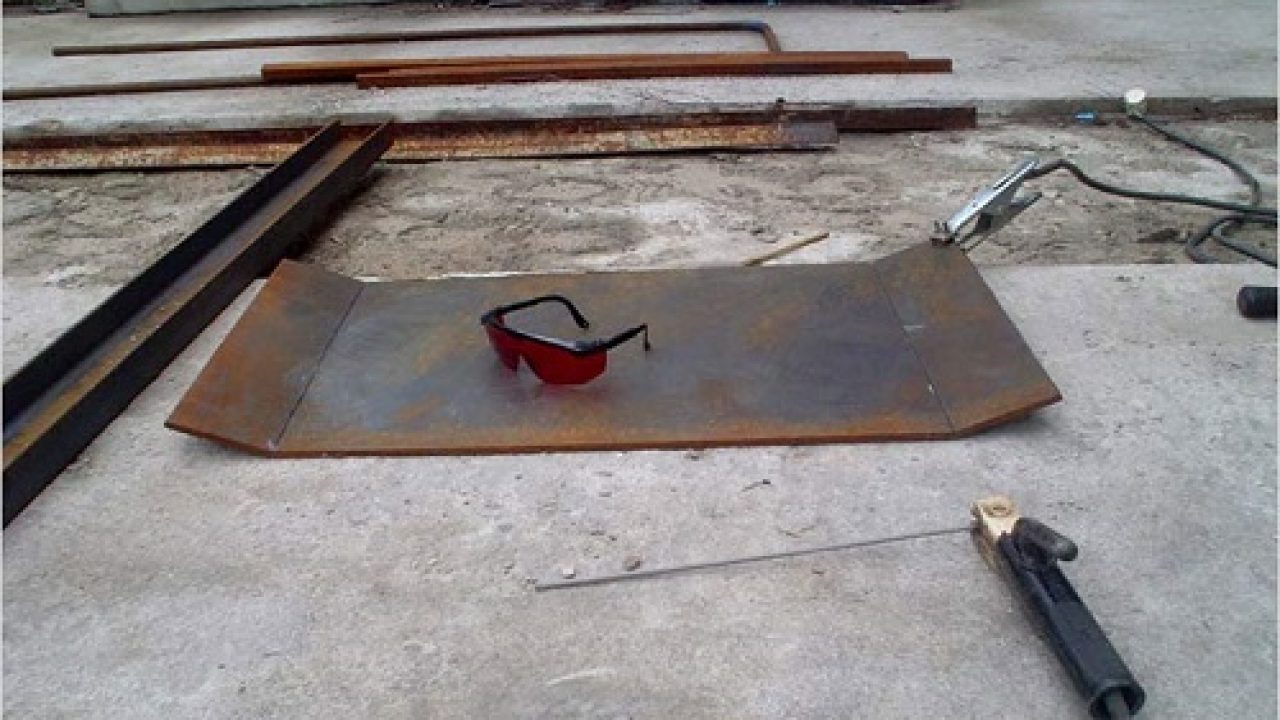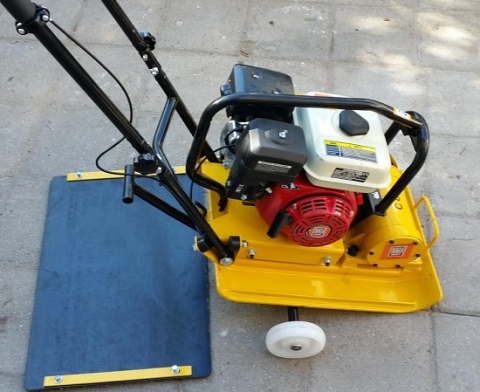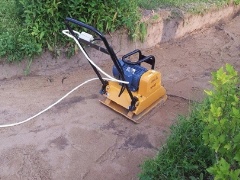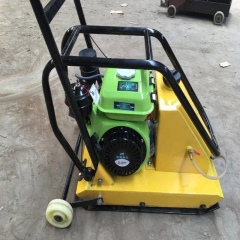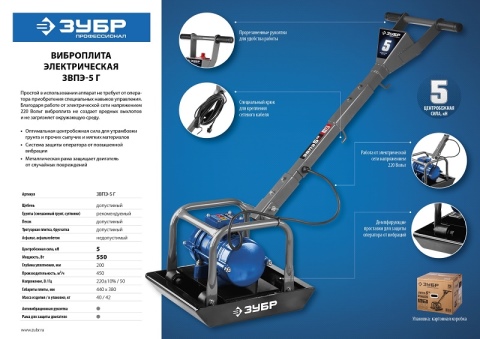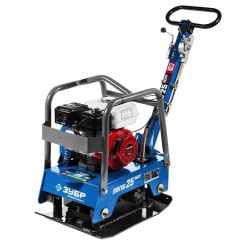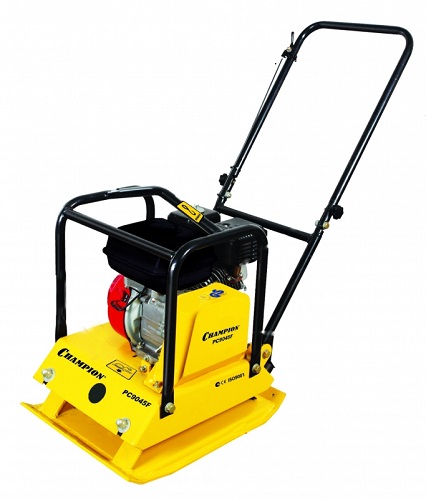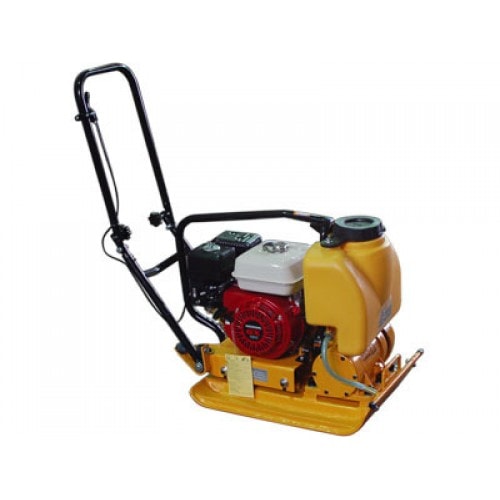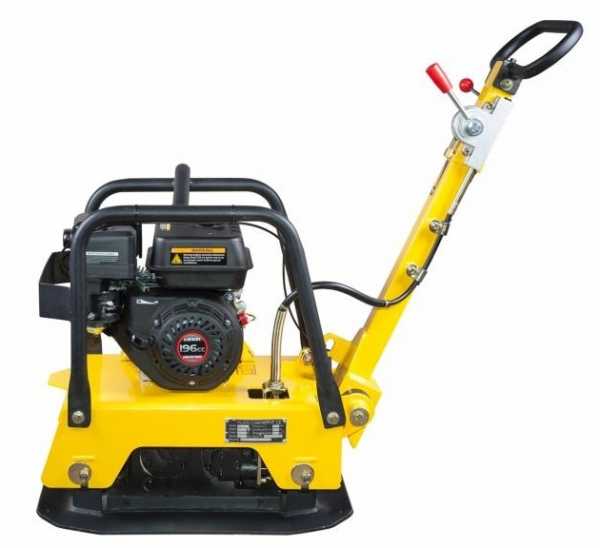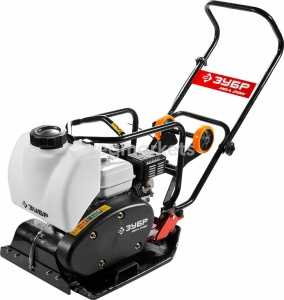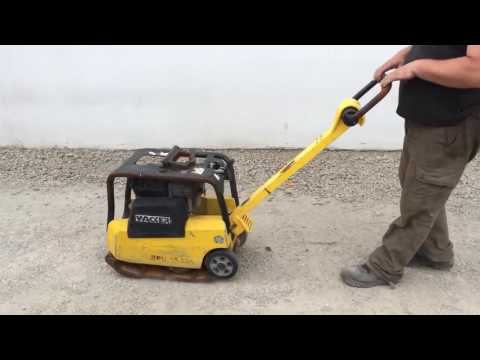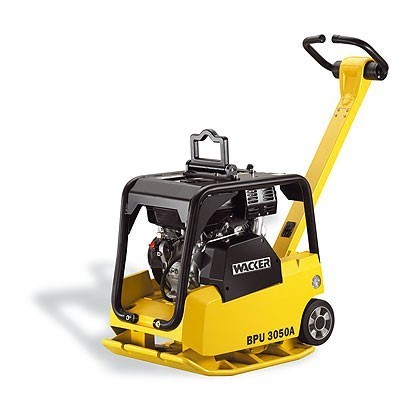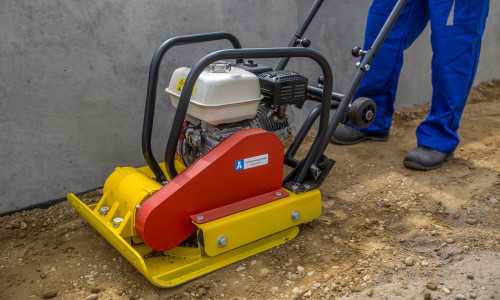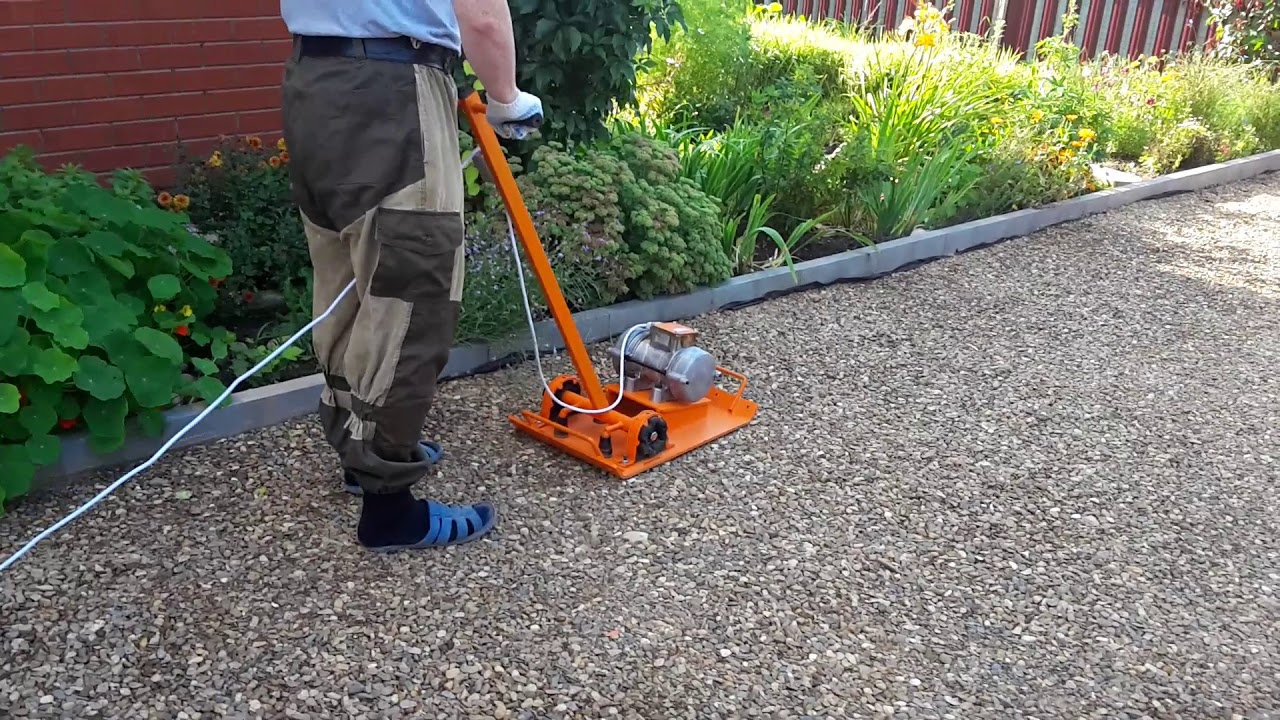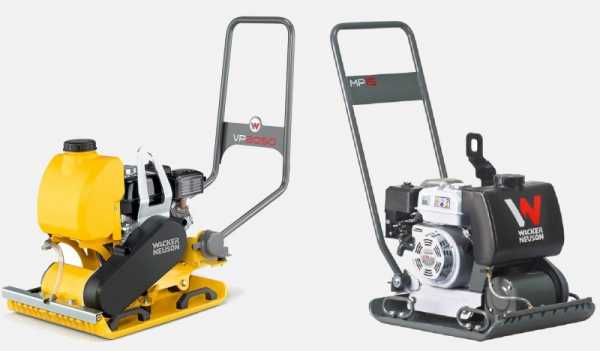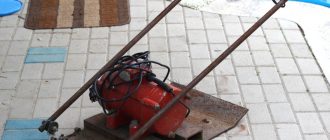Pressing machine design
The design of the electric vibrating plate contains perfectly matched components and parts that allow you to work on surfaces of any relief. As standard, road construction equipment is equipped with:
- steel tray;
- tubular stand;
- directional vibration exciter;
- pressure shock absorbers;
- control elements;
- protection unit.
The principle of operation of the device is based on the properties of centrifugal force, which creates oscillatory movements of the tray, the frequency of which is regulated by the control system. Due to its small size and weight, the device can be easily transported to the desired place without the use of cargo trolleys or vehicles. Unlike other models, the electrically powered vibrating plate can be used to compact the screed indoors.
Electrical appliances of different capacities can be connected to household and industrial networks 220 V and 380 V. The electric vibrating plate 220 V copes well with compaction of sand, soil, gravel, paving slabs and foundations. The machine has low power ratings, but the demand for this type of equipment remains high due to its productivity.
What is the device of a vibrating plate?
So, the main mechanism in the device of the vibrating plate is the working plate, on which other units are installed: a vibrator, a motor frame, an engine, a centrifugal clutch. The main mechanism is, of course, a vibration exciter, the main parts of which are the unbalanced shaft (s) and the cylinder-shaped housing. The structure is fixed with clamps and attached to the plate with bolts. If there is only one shaft, then the plate can only move in one direction and it is called, respectively, single-shaft. Twin-shaft vibratory plates can move back and forth (so-called reversible vibratory plates). The unbalanced shaft is installed in bearing arrangements.

An important detail in the device of the vibrating plate, which is also attached to the plate, is the motor frame. Mounting method - using shock absorbers. An engine is installed on the motor frame, which can be powered by gasoline, diesel or electricity. The engine shaft has a centrifugal clutch that operates at 2,200 rpm. Through the V-belt transmission, rotation is carried out (transmitted) from the coupling to the vibrator shaft.
Read Vibratory Rollers in Service for Road Builders
Some cookers are equipped with a water tank (mounted on the carrier). Additional elements that do not affect the basic principle of operation of the vibrating plate, but make the operator's work more comfortable, include shock-absorbing mats, gloves that dampen the load from vibration, etc.
This device of a vibrating plate is standard, the principle of operation of a vibrating plate of any manufacturer is vibration. But we see it necessary to dwell in detail on the more significant mechanisms of this device.

Dimensions and weight
Depending on the type of engine, vibratory plates are light and heavy. In addition to their weight, the size of the tool is of no small importance. When choosing a model, you should know that vibrating plates are produced in the following ranges of overall parameters:
- tool width - minimum 0.32 m, maximum 0.5 m;
- equipment length - minimum 0.78 m, maximum 1.1 m;
- vibrating plate height - minimum 0.78 m, maximum 1.08 m;
- the length of the ramming surface - from 0.45 m to 0.62 m;
- the width of the ramming surface is from 0.32 m to 0.48 m.
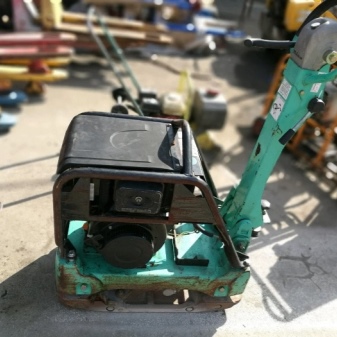

Depending on the weight, all types of vibrating plates are divided into 3 categories.
- Lightweight models up to 75 kg.These are the smallest versions of the tool that are used for domestic use. Such a plate compactor can cope with a soil layer not exceeding 150 mm. Often, a light type of tool is used in the process of laying sidewalk paths.
- Universal models weighing 75-90 kg. Such units can compact a soil layer equal to 250 mm. They are used to prepare asphalt-type roadways.
- Medium-weight models weighing 90-140 kg. The devices are professional and are used to perform preparatory road works. The plate compactor is capable of performing large volumes of ramming in a short period of time. The thickness of the processed layer will be 600 mm.
- Heavy models from 140 kg and above. Such professional vibrating machines are used only for construction and road works of narrow specificity.
What else to consider when choosing a vibratory plate?
In addition to the most important parameters listed above, it is important to consider the following factors:
- performance, i.e. what area of material the device will compact per unit of time. The parameter depends on the weight of the vibrating plate, power, working surface area, measured in m2 / hour;
- speed also affects the efficiency of the work carried out. The more powerful the engine, the higher the speed. For modern units, this parameter ranges from 5-30 m / min. However, the higher the speed you use, the shallower the compaction depth will be;
- operating time without refueling depends on the volume of the tank, the type of engine and the fuel. The parameter is individual for each model, but the average time of continuous operation with a full tank is about 2-3 hours;
- an irrigation system is only necessary when working with asphalt or concrete rammers. Water prevents material from sticking to the unit. The recommended volume of the water tank is 3-5 liters;
- A polyurethane or rubber mat is useful when working with paving slabs or stones. The mat somewhat reduces the destructive effect of vibration on such fragile materials and prevents damage to them;
- manufacturer. The reliability and durability of the equipment largely depends on the manufacturer's name. You can highlight the equipment of the following brands: Wacker Neuson, Weber, Bomag, NTC (Europe), Mikasa (Japan), Shatal (Israel). Vibratory plates produced by Caliber, TSS, Splitstone, MISSOM have shown themselves quite well among domestic ones. Also worth noting is the high quality of Grost, Zitrek, Tsunami, Impulse, Champion and Diam products.
What kind of vibrating plates are there?
There are three types of vibrating plates according to the type of internal combustion engine. Each species has its own characteristics, a set of pros and cons. Let's consider everything in order.
Electric vibrating plates
Read Electric vibrating plate: a rare "beast" in the construction "forest"
A significant advantage of this unit is the fact that it creates little noise, and when tamping a sand cushion, you will not pollute the atmosphere with harmful substances, combustion products and others. But such a device consumes a lot of energy (to obtain the required power) and is not portable.
Diesel Vibratory Plates
These vibratory plates are chosen because they have the best power and impact energy, coupled with low (in comparison with gasoline) fuel consumption. Most often, such devices are used in industrial construction because of their performance and large size. True, for all its positive qualities, you will have to pay accordingly.
Gasoline Vibratory Plates
An obvious plus is mobility due to its small size. In addition, a gasoline vibrating plate does not create a lot of noise, especially this plus will be relevant when laying paths and communications near the house. It is forbidden to use it in unventilated rooms - however, as well as a diesel one. The disadvantage of such a device is high fuel consumption.
By the type of ramming, direct and reversible vibrating plates are distinguished.

